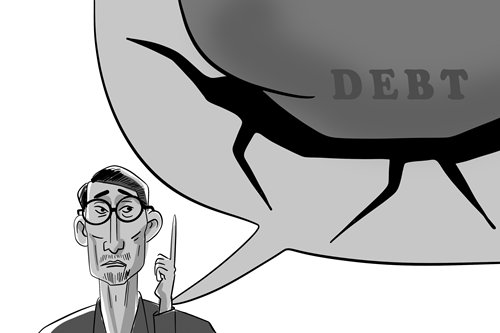COMMENTS / INSIDER'S EYE
China’s debt trap? The true story of Hambantota port

Illustration: Luo Xuan/GT
The fate of Hambantota port, which the Sri Lankan government leased to a Chinese firm for 99 years, has been hotly debated since the launch of the Belt and Road Initiative (BRI).
Western experts and media have used the port as proof that China is using the BRI as a tool for creating a debt trap and gaining ownership of vital infrastructure.
The proposed Hambantota port was expected to relieve pressure on the Colombo port and to provide services to ships that detour to secure services such as refueling, maintenance, logistics and buying provisions and medical supplies.
India was the first country Sri Lanka turned to for financial help to build Hambantota port. However, the request was rejected as India deemed the project commercially unviable.
When costs for the first phase were being discussed in 2006-07, Sri Lanka did try to seek a preferential loan from China, but China was unable to provide as funds were already dedicated to other projects at that time.
Sri Lankan officials instead negotiated a commercial rate based on the London InterBank Offered Rate (LIBOR), which was around 5.5 percent and rising. After many negotiations, Export-Import Bank of China eventually agreed to fund 85 percent of Hambantota port's first phase construction with a 15-year commercial loan of $306 million at an interest rate of 6.3 percent, including a management fee of 0.3 percent.
Financing for phase two of the port of Hambantota was negotiated after the 2008 financial crisis, and the interest rate was much lower. The rate was around 2 percent when LIBOR was under 1 percent. The risk premium accorded to Sri Lanka was quite high at the time because of the ongoing civil conflict.
At no time did China put pressure on Sri Lanka to accept any specific terms or conditions, nor did they entice additional borrowing by offering low rates.
Sri Lanka Ports Authority (SLPA) operated the Hambantota port from 2012 to the end of 2014, a period that saw little traffic. Likewise, bunkering business failed to take off due to SLPA not having a strategic international partner.
Hambantota port was unable to generate sufficient revenue to meet its loan obligations due to inadequate governance, lack of commercial and industrial activities, and its inability to attract passing vessels to dock at the port. By the end of 2016, it suffered a total loss of $304 million.
There was a change of government in Sri Lanka in January 2015. The new administration suspended port operations, including bunkering. However, the four-year payment moratorium is coming to an end.
Amid mounting pressure to meet the IMF's bailout terms and loan repayment obligations, the Sri Lankan government struck a public-private partnership (PPP) deal with China in July 2017. The PPP is not a debt-equity swap but fresh investment by China Merchants Port Holdings Co.
At no time did China intend to take the Hambantota port. It was the Sri Lankan government that requested China bail out the Hambantota port after it incurred heavy losses.
Under the concession agreement, Sri Lanka did not confer any special status to the operators, either in terms of extraterritorial rights or fiscal regime. Sri Lankan Police, Customs, Navy and Emigration officials manage all vessels, personnel and cargo in and out of the port.
China neither enticed nor compelled Sri Lanka to borrow money. Currently, Sri Lanka's total sovereign debt stands at about $65 billion. China only accounts for $8.5 billion of the total foreign debt, of which Hambantota port is a mere $1.12 billion.
The Hambantota port's failure is mainly because Sri Lanka is an emerging country lacking management skill and an international cooperation network. Once these issues are overcome, Hambantota port is expected to have a very bright future.
When its neighbor and multilateral development banks turned their backs, China provided the funding and built Hambantota port with good intentions. The process reflected the BRI spirit.
A New York Times article alleged that China lured Sri Lanka into a debt trap under the BRI. However, we now know that the port project began in 2007, while the BRI was launched in 2013, and lending was not tied to any strategy.
The BRI is an initiative proposed by China, but it benefits others, too. It aims to strengthen economic cooperation, promotes the free flow of production factors, and optimizes resource distribution. At the same time, the BRI has become a target of criticism from vested interests and those with ill intent. The story of Hambantota was twisted, and China got the blame.
The author is a member of Pangoal's Academic Committee, and deputy secretary general of the Belt and Road Research Center, Chinese Academy of Social Sciences. bizopinion@globaltimes.com.cn
